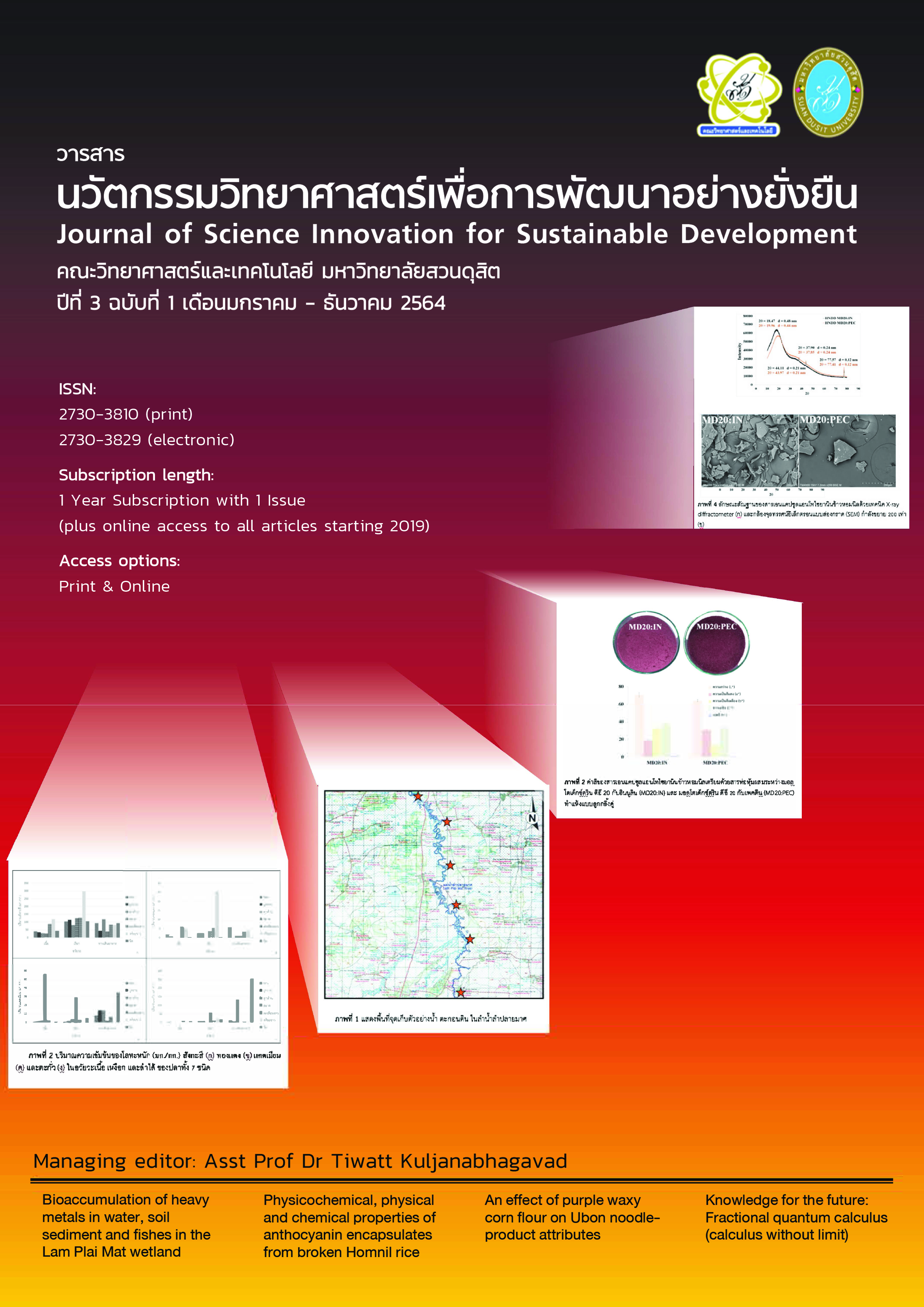การผลิตยางเครปบางสีน้ำตาลเกรดพรีเมียมจากยางก้อนถ้วยคุณภาพดี ปรีดิ์เปรม ทัศนกุล* และ บัญชา สมบูรณ์สุข
Main Article Content
บทคัดย่อ
การปฏิบัติทางการเกษตรที่ดี (GAP) และการปฏิบัติที่ดีในกระบวนการผลิต (GMP) เป็นข้อกำหนดขั้นพื้นฐานที่ช่วยให้ผู้ผลิตผลิตสินค้าที่มีคุณภาพและตรงตามมาตรฐาน การศึกษาในครั้งนี้ได้เลือกกลุ่มตัวอย่างแบบเจาะจงด้วยการส่งเสริมให้กลุ่มเกษตรกรผลิตยางเครปบางสีน้ำตาลเกรดพรีเมียมจากยางก้อนถ้วย GAP โดยมีวัตถุประสงค์เพื่อจัดทำมาตรฐาน วิเคราะห์ความคุ้มค่าทางเศรษฐศาสตร์ และสร้างมูลค่าเพิ่ม ผลการศึกษาพบว่ายางก้อนถ้วยและยางเครป ได้รับการยกระดับเป็นมาตรฐานสินค้าเกษตร และเพิ่มมูลค่าการผลิตยางก้อนถ้วยร้อยละ 21.93 การวิเคราะห์ความคุ้มค่าทางเศรษฐศาสตร์พบว่าการผลิตยางเครปบางสีน้ำตาลเกรดพรีเมียมมีค่า NPV มากกว่าศูนย์ BCR มากกว่า 1 แสดงถึงความคุ้มค่าต่อการลงทุน ที่สำคัญรัฐบาลได้นำโครงการการขับเคลื่อนเศรษฐกิจฐานรากมาตรฐาน GAP และ GMP เป็นยุทธศาสตร์ของชาติที่สามารถสร้างมูลค่าเพิ่มรวมทั้งความยั่งยืนแก่เกษตรกรชาวสวนยาง และเพื่อให้การขับเคลื่อนการปฏิบัติตามมาตรฐาน GAP และ GMP ได้นั้น ควรได้รับความร่วมมือทุกภาคส่วนทั้งภาคเกษตรกร ภาครัฐ และภาคเอกชน
Article Details

อนุญาตภายใต้เงื่อนไข Creative Commons Attribution-NonCommercial-NoDerivatives 4.0 International License.
ลิขสิทธิ์ต้นฉบับที่ได้รับการตีพิมพ์ในวารสารนวัตกรรมวิทยาศาสตร์เพื่อการพัฒนาอย่างยั่งยืนถือเป็นกรรมสิทธิ์ของคณะวิทยาศาสตร์และเทคโนโลยี มหาวิทยาลัยสวนดุสิต ห้ามผู้ใดนำข้อความทั้งหมดหรือบางส่วนไปพิมพ์ซ้ำ เว้นแต่จะได้รับอนุญาตอย่างเป็นลายลักษณ์อักษรจากคณะวิทยาศาสตร์และเทคโนโลยี มหาวิทยาลัยสวนดุสิต นอกจากนี้ เนื้อหาที่ปรากฎในบทความเป็นความรับผิดชอบของผู้เขียน ทั้งนี้ไม่รวมความผิดพลาดอันเกิดจากเทคนิคการพิมพ์
เอกสารอ้างอิง
การยางแห่งประเทศไทย. สำนักงานตลาดกลางพาราจังหวัดสงขลา. (2564). รายงานผลการดำเนินงานสำนักงานตลาดกลางพาราจังหวัดสงขลา ปี 2564. สงขลา.
ปรีดิ์เปรม ทัศนกุล. (2555). มหันตภัยร้ายของเกลือแคลเซียมในการผลิตยางก้อนถ้วย. วารสารยางพารา. 33 (2), 23–27.
ปรีดิ์เปรม ทัศนกุล. (2556). เอกสารคำแนะนำสำหรับชาวสวนยาง คู่มือการผลิตยางก้อนถ้วยคุณภาพดี. เอกสารวิชาการ. กรุงเทพฯ: ฝ่ายวิจัยและพัฒนาอุตสาหกรรมยาง การยางแห่งประเทศไทย.
ปรีดิ์เปรม ทัศนกุล. (2557). ปัจจัยที่ใช้ในการควบคุมคุณภาพยางแท่งจากยางแห้ง. วารสารยางพารา. 35(2), 19–31.
ปรีดิ์เปรม ทัศนกุล. (2558). หยุดการใช้กรดซัลฟิวริกในการจับตัวยาง. วารสารยางพารา. 36(4), 26–30.
ปรีดิ์เปรม ทัศนกุล. (2564). การจัดการสวนยางมาตรฐาน GAP สู่การผลิตยางแผ่นอบแห้งมาตรฐาน GMP กรณีศึกษา ศูนย์การเรียนรู้มูลนิธิรัฐบุรุษ พลเอกเปรม ติณสูลานนท์. การประชุมวิชาการระดับชาติครั้งที่ 6 และการประชุมระดับนานาชาติครั้งที่ 2. สถาบันเทคโนโลยีพระจอมเกล้าเจ้าคุณทหารลาดกระบัง วิทยาเขตชุมพรเขตอุดมศักดิ์ จังหวัดชุมพร.
พิศิษฐ์ พิมพ์รัตน์, วรพงษ์ พูนสวัสดิ์, และกรรณิการ์ สหกะโร. (2564). ผลของการใช้กรดฟอร์มิกและกรดซัลฟิวริก เป็นสารจับตัวยางที่มีความเข้มข้นต่างกัน 4 ระดับ ต่อสมบัติของยางแท่งเอสทีอาร์ 20 สมบัติการคงรูปของยางคอมพาวนด์ และสมบัติเชิงกลของยางหลังคงรูป. วารสารยางพารา. 42(2), 11–23.
มาตรฐานการยางแห่งประเทศไทย. มกยท. 3–2564. ยางเครปบางสีน้ำตาลเกรดพรีเมียม; ข้อกำหนด. การยางแห่งประเทศไทย. กรุงเทพฯ.
มาตรฐานสินค้าเกษตร. มกษ 5907–2561. การปฏิบัติที่ดีสำหรับการผลิตยางเครป. สำนักงานมาตรฐานสินค้าเกษตรและอาหารแห่งงชาติ. กระทรวงเกษตรและสหกรณ์. กรุงเทพฯ.
มาตรฐานสินค้าเกษตร. มกษ 5908–2562. การปฏิบัติทางการเกษตรที่ดีสำหรับยางพารา เล่ม 1 การผลิตน้ำยางสด. สำนักงานมาตรฐานสินค้าเกษตรและอาหารแห่งงชาติ. กรุงเทพฯ.
มาตรฐานสินค้าเกษตร. มกษ 5910–2563. การปฏิบัติทางการเกษตรที่ดีสำหรับยางพารา เล่ม 2 การผลิตยางก้อนถ้วย. สำนักงานมาตรฐานสินค้าเกษตรและอาหารแห่งงชาติ. กรุงเทพฯ.
สถาบันวิจัยยาง. (2544). การทดสอบตามมาตรฐานยางแท่งเอสทีอาร์. เอกสารวิชาการที่ 1/2544. พิมพ์ครั้งที่ 2/2544. สถาบันวิจัยยาง กรมวิชาการเกษตร กรุงเทพฯ.
สมศักดิ์ ศิริวนารังสรรค์ และอุทัยวรรณ บุตรแพง. (2558). รูปแบบการจัดการปัญหาเหตุรำคาญเรื่องกลิ่นจากการประกอบกิจการที่เป็นอันตรายต่อสุขภาพประเภทการสะสมยางก้อนถ้วย. วารสารอนามัยสิ่งแวดล้อม. 18(1), 60–80.
The Rubber Manufacturers Association. (1979). International Standards of Quality and Packing for Natural Rubber Grades. (The Green Book). Washington, D.C. United States. p. 6–8.
Yunyongwattanakorn, J., et al. 2003. Study the effect of proteins and fatty acids on storage hardening and gel formation under various conditions during accelerated storage of various kinds of natural rubber. Rubber Chemistry Technology. 76: 1228–1240.


